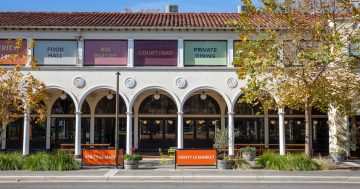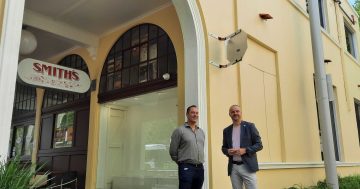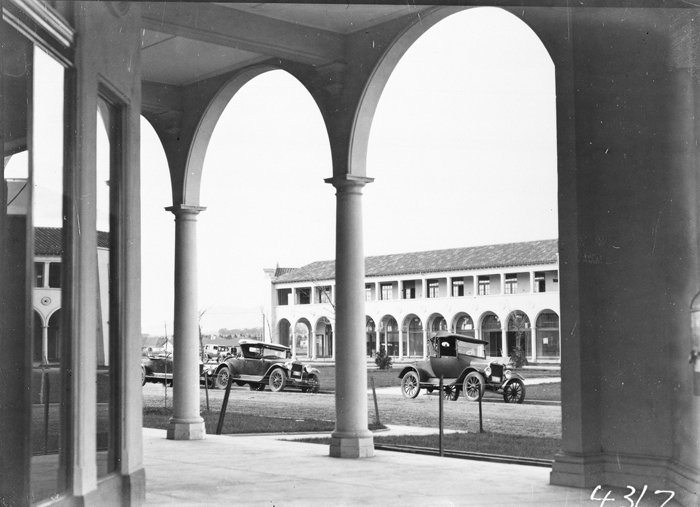
Fast forward for a moment: it is early 2019 and the first sleek and shiny new tram glides down Northbourne Avenue on its maiden voyage from Gungahlin into the Civic Terminus adjacent to the Sydney and Melbourne buildings. Schoolchildren line the route waving commemorative flags at the first tram, full of dignitaries from all over the world.
These are people who could have power and influence over investment in the capital of Australia. A perfect day in a perfect city. What could possibly go wrong with this vision?
As the tram gently glides into the Civic Terminus, the VIPs are astonished at what they see. What was once a pair of much loved inter-war Mediterranean-style building with gracious shady colonnades, are now in a state of advanced decay. They have been allowed to degenerate into a series of individual leaseholdings that have not been required to follow even the most basic of heritage principles. The exterior paint is fifty shades of beige, and the shabby colonnades shelter ugly mismatched shop fronts with poorly designed contemporary signage.

Sydney Building shopfront painted ‘mission brown’
We do need to understand how these much-loved buildings got into this state because this is also what they look like today. They were the first to be built by private enterprise in Canberra commencing in 1926, and were built in sections, like Paddington terrace houses.
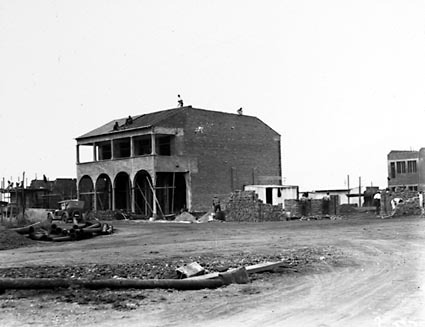
Building in progress showing how both buildings were built in sections. Image courtesy of National Archives of Australia: A3560, 2573
They are actually divided into a number of individual leases, with a variety of leaseholders operating small businesses ranging from convenience stores to restaurants and hair salons. The leaseholders are individually responsible for maintenance and we can assume are not restrained by specific heritage guidelines. Although the buildings are listed on the ACT Heritage Register, this only protects the heritage value of the place, but does also suggest a need to prepare a conservation management plan.
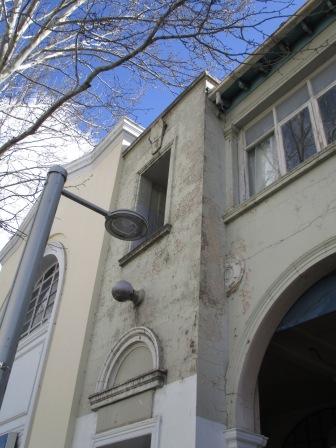
Sydney Building with peeling and mismatched paint.
The fairly obvious conclusion is something needs to be done – and done now. How do we move forward to achieve an appropriate portal for Civic? At the worst, leaseholders will probably need assistance to repair and paint the exteriors a uniform heritage colour. The immediate disadvantage is current leaseholders will resist such a move, as it will be at their own expense. So what is a possible alternative? At the best, the new government could make a very brave decision, and as part of their already expensive City Metro pet project, take on board the need to do something radical. They could buy back all the leases and clean up and repair both the exterior of the buildings and the shop fronts. This would create the sort of united exterior imaged by the architect of these iconic buildings, Sir John Sulman.
The buildings could then be re-leased with a very specific purpose and shared vision for a new precinct worthy of a capital city: galleries; cafes; bistros with live music; flower stalls; and artist studios. And outside across the tram tracks in the new central plaza public artworks that are currently neglected or vilified elsewhere in Canberra could be re-sited to a setting where they can be appreciated. Imagine Bert Flugelman’s delightful Tumbling Cubes, poorly sited and prone to random damage in a quiet corner of the Belconnenn Town Centre, relocated to the new plaza and protected by a small moat of water.

Bert Flugelman’s Tumbling Cubes, Belconnen Town Centre
With no heritage management plan for these buildings, and if something doesn’t happen in the very near future, the shameful neglect and decay of these important portals, the Sydney and Melbourne buildings, will reach a stage where it will be very expensive to ameliorate the entrenched decay. The new ACT government needs to act decisively and act now.
Main picture: Looking through the colonnades of the Melbourne Building towards the Sydney Building about 1930. Image courtesy of National Archives of Australia from Mildenhall collection: A3560, 4317.












